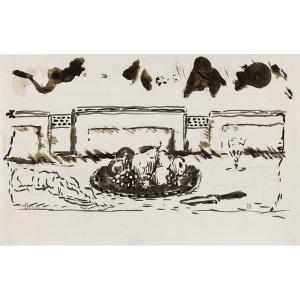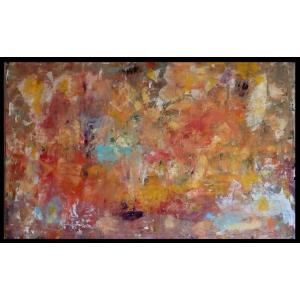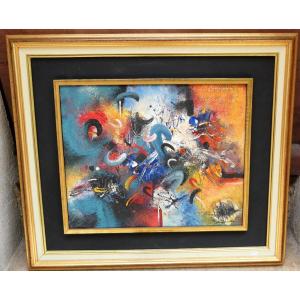Mixed media on paper, bearing the studio sale stamp on the back.
21 x 27 cm
Provenance:
Sale of the Dora Maar estate, Piasa - Mathias, Paris, October 28-29, 1998
Private collection, Paris
Dora Maar: Alone on the Edge of the Earth
HenrietteThéodora Markovitch was born in Paris but raised in Argentina, where her father, an architect of Croatian origin who had settled in France, had won several commissions.
Returning to Paris in 1926, the young woman, who had set her sights on painting, enrolled in André Lhote's studio in Montparnasse.
On the advice of her friend, art critic Marcel Zahar, she also enrolled at the Paris School of Photography. It was in this field that she made her name, using photography in her plastic research at the heart of the Surrealist movement.
Dora Maar's name is inextricably linked to that of the most famous painter of the 20th century. Having been his muse and lover for almost ten years, she is forever in the collective imagination as “the weeping woman”, painted many times by Picasso. Dora Maaris also in the shadow of another myth: Man Ray, whose assistant she was forsome time. However, after sharing a studio with Pierre Kefer between 1930 and 1934, she was able to set up her own photography studio at 29 rue Astorg.
In her studio, she produced advertising photography and nudes for charm magazines, but she also devoted herself to formal and experimental research, and to the practice of artistic photography, in which she proved to be particularly gifted and daring. Under the pseudonym Dora Maar, she composed strange photomontages, sometimes erotic, sometimes poetic, dreamlike and disturbing, works of latent sensuality that made her one of the best ambassadors of the Surrealist movement.
Involved in an extreme-left activist group, she met writer Georges Bataille, whose mistress she remained for a time, and signed the Contre-Attaque manifesto with him, a political tract proclaiming the fighting union of revolutionary intellectuals around Bataille and Breton, in October 1935.
It was then that she was about to meet Picasso. Paul Éluard portrayed her at the Deux Magots café as a dangerously passionate woman who, when the Minotaur saw her, amused herself by sticking a pen knife between her fingers on the table. Years of stormy passion followed. Dora Maar'sphotographs document the work of the painter harnessed to the great machine of Guernica in 1937, and these works showing the successive states of the work serve to advance the painting. Both were also curious about the thousand and one formal facets of photography: etching on film, photograms, “clichés-verre”... Encouraged by Picasso, Dora Maar also returned to painting, exploring the cubist vein, inevitably influenced by the master.
The separation from Picasso was a brutal shock from which Dora Maar never seemed to recover. For a time, she was even institutionalized. Yet she continued to paint, landscapes and evocations that met with abstraction and a certain mysticism in which she had come to take refuge. She decided to divide her time between Paris and Ménerbes, where she ended up living in poverty and seclusion.
Marcel Fleiss, who met her towards the end of her life, described her Paris apartment as “a tramp's den”. She deliberately cut herself off from all her friends, and openly displayed anti-Semitic and homophobic ideas. She was a lonely woman who left this world at the end of the 1990s, with its contradictions, the flashes of youth and the shadowy side of this old woman, on whom the disconsolate, jilted lover had laid her burden. She was laid to rest in the Clamart communal cemetery, where only five people followed the cortege.
Her painted work remained virtually unknown, until a posthumous auction in 1999 revealed the extent of her plastic research, which had never left her studio. In 2019, the Centre Pompidou, which owns a significant body of her photographic work, will devote a major retrospective to her, revealing her multiple talents to the general public.
Discover more works by this artist on the gallery's website: https://www.galeriepentcheff.fr/fr/peintre-dora-maar#Oeuvres




































 Le Magazine de PROANTIC
Le Magazine de PROANTIC TRÉSORS Magazine
TRÉSORS Magazine Rivista Artiquariato
Rivista Artiquariato